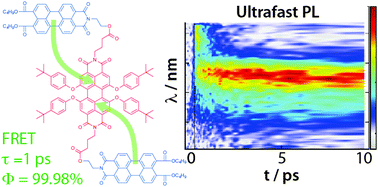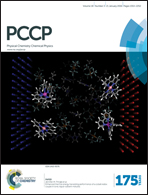Quantifying highly efficient incoherent energy transfer in perylene-based multichromophore arrays†
Abstract
Multichromophore perylene arrays were designed and synthesized to have extremely efficient resonance energy transfer. Using broadband ultrafast photoluminescence and transient absorption spectroscopies, transfer timescales of approximately 1 picosecond were resolved, corresponding to efficiencies of up to 99.98%. The broadband measurements also revealed spectra corresponding to incoherent transfer between localized states. Polarization resolved spectroscopy was used to measure the dipolar angles between donor and acceptor chromophores, thereby enabling geometric factors to be fixed when assessing the validity of Förster theory in this regime. Förster theory was found to predict the correct magnitude of transfer rates, with measured ∼2-fold deviations consistent with the breakdown of the point-dipole approximation at close approach. The materials presented, along with the novel methods for quantifying ultrahigh energy transfer efficiencies, will be valuable for applications demanding extremely efficient energy transfer, including fluorescent solar concentrators, optical gain, and photonic logic devices.


 Please wait while we load your content...
Please wait while we load your content...